On December 7th in Brasília, the Brazilian Coordination for the Improvement of Higher Education Personnel (CAPES) awarded the prizes to the best doctoral theses defended in 2016 in graduate programs in Brazil. The authors of the theses selected received a diploma, medal and a national postdoctoral fellowship of up to 12 months, in addition to pay the travel expenses of the author and thesis supervisor to participate in the awards ceremony.
B-MRS Newsletter interviewed some of the winners, who were rewarded for their work on materials field. Meet these four young doctors and their works.
Interview with Eliézer Fernando de Oliveira, winner of the award for the best thesis in the Materials area
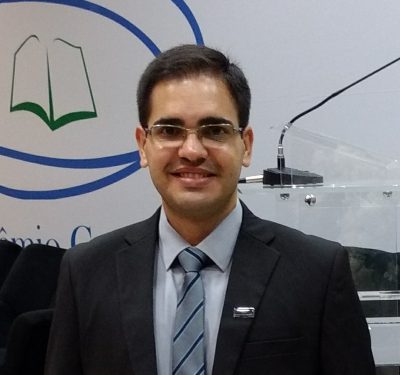
Thesis: Electronic structure of organic materials for applications in the active layers of solar cells.
PhD Course in Materials Science and Technology – POSMAT, State University of São Paulo Júlio de Mesquita Filho (UNESP).
Author: Eliézer Fernando de Oliveira
Advisor: Francisco Carlos Lavarda (UNESP – campus Bauru)
In his master’s thesis, Eliézer Fernando de Oliveira, who holds a degree in Physics, had already immersed in the topic of conductive polymers for solar cell application. During the PhD, his deep involvement continued, with great results. In fact, he was able to determine that by means of computational methods it is possible to predict certain properties of new polymers in order to choose, before producing them, the most suitable ones for the desired application. Using this method, Eliézer de Oliveira suggested in the thesis a series of new polymers that would be more efficient than the one used so far to convert solar energy to electric energy in solar cells. During his doctorate, Oliveira comprehensively used the computational resources of the Center of Scientific Computing of UNESP and carried out an internship at Instituto Madrileño de Estudios Avanzados en Nanosciencia (Spain). Oliveira is currently a postdoctoral fellow at Unicamp.
B-MRS Newsletter: In your opinion, what is the most relevant contribution of the awarded thesis?
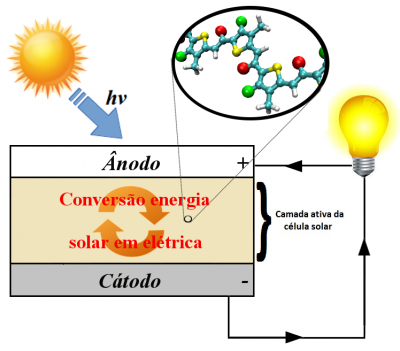
Eliézer de Oliveira: My doctoral work focused on exploring new organic materials, more specifically conductive polymers for application in the active layers (where conversion from solar to electric takes place) of solar cells to obtain these materials in a planned way using calculation methods of the electronic structure of materials. This work contributed to the area, since we suggested several new polymers that display better electronic and transport properties than those already in use. In my opinion, most relevant aspect of the work was the fact that we demonstrated there is a way to predict in advance the electronic and optical properties of new copolymers with similar comonomers. In these types of polymers, the repeating unit (monomer) is formed by two comonomers that are similar to each other (based on the same compound), only differing the functional groups that are in each comonomer. This demonstrated, by means of a linear relation, that we can determine the electronic and optical properties of a copolymer constructed by various compositions of similar comonomers. This allows for an initial analysis to choose the copolymers that actually present a real application so that later they can be synthesized.
B-MRS Newsletter: Cite the main results generated from the award-winning thesis (papers, patents, products, startups, other awards, etc.).
Eliézer de Oliveira: Eight scientific articles related to the topic of my PhD thesis were published.
- Oliveira, E. F.; Lavarda, F. C. Effect of the length of alkyl side chains in the electronic structure of conjugated polymers. Mat. Res. 2014, 17, 1369-1374 (DOI: 10.1590/1516- 1439.278814)
- Oliveira, E. F.; Lavarda, F. C. Molecular design of new P3HT derivatives: Adjusting electronic energy levels for blends with PCBM. Mater. Chem. Phys. 2014, 148, 923-932 (DOI: 10.1016/j.matchemphys.2014.09.002)
- Oliveira, E. F.; Lavarda, F. C. Copolymers with similar comonomers: tuning frontier orbital energies for application in organic solar cells. Polym. Eng. Sci. 2016, 56, 479-487 (DOI: 10.1002/pen.24275).
- Oliveira, E. F.; Roldao, J. C.; Milián-Medina, B.; Lavarda, F. C.; Gierschner, J.; Calculation of low bandgap homopolymers: Comparison of TD-DFT methods with experimental oligomer series. Chem. Phys. Lett. 2016, 645, 169-173 (DOI: 10.1016/j.cplett.2015.12.059).
- Oliveira, E. F.; Lavarda, F. C. Reorganization energy for hole and electron transfer of poly(3-hexylthiophene) Derivatives. Polymer 2016, 99, 105-111 (DOI: 10.1016/j.polymer.2016.07.003).
- Oliveira, E. F.; Silva, L. C.; Lavarda, F. C. Modifying electronic properties of ICBA through chemical modifications for solar cell applications. Structural Chemistry 2017, 28, 1133–1140 (DOI: 10.1007/s11224-017-0916-0)
- Oliveira, E. F.; Lavarda, F. C. Design of diblock co-oligomers as low bandgap small molecules for organic solar cells. Molecular Simulation, 2017, 43, 1496-1501 (DOI: 10.1080/08927022.2017.1321759).
- Oliveira, E. F.; Shi, J.; Lavarda, F. C.; Lüer, L.; Milián-Medina, B.; Gierschner, J. Excited state absorption spectra of dissolved and aggregated distyrylbenzene: a TD-DFT state and vibronic Analysis. Journal of Chemical Physics, 2017, 143, 034903 (DOI: 10.1063/1.4993216)
B-MRS Newsletter: In your opinion, what are the main factors that led to the outstanding research at the national level (your thesis)?
Eliézer de Oliveira: A major factor was scientific funding. During my PhD I had a Fellowship from the São Paulo Research Foundation (FAPESP). This grant enabled my exclusive dedication to research, to participate in national and international conferences and to carry out an internship abroad. Another important factor regarding the theoretical computational aspect of the research was the resources provided by the Center of Scientific Computation (NCC) of the Sao Paulo State University (UNESP) that allowed the computational simulations indispensable for my research. Last but not least, I received great mentoring from my doctoral supervisor and support from my family and friends, all of which was crucial to the success of my scientific career.
B-MRS Newsletter: Leave a message to our readers who are undergraduate or graduate students.
Eliézer de Oliveira: Be patient and remain firm. Scientific trajectory depends on constant research and dedication; during this trajectory maintain a good relationship with your advisor, look for good partnerships and consider the quality of the work produced. There is much to investigate about the universe of science, as Isaac Newton said “What we know is a drop, what we don’t know is an ocean.”
Interview with André Luiz da Silva, winner of the honorable mention of the Materials area
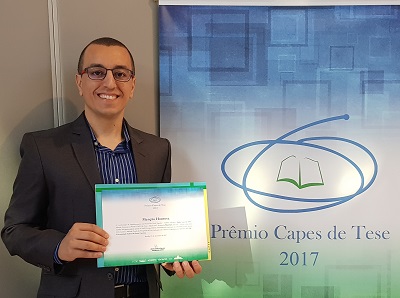
Thesis: Anatase-rutile phase stability and photocatalytic activiy of Nb2O5-Doped TiO2.
PhD Course in Materials Science and Engineering from the Brazilian Federal University of Santa Catarina (UFSC).
Author: Andre Luiz da Silva.
Advisors: Dachamir Hotza (UFSC), Ricardo H. R. Castro (UC Davis, USA) e Michele Dondi (ISTEC, Italy)
When he began his doctorate, André Luiz da Silva, Ceramics technologist with a Master’s in Materials Science and Engineering, proposed a useful contribution to the ceramic coating industry, a segment in which he had worked for 10 years. The chosen theme was the stabilization of one of the phases of titanium dioxide (TiO2) for application in self-cleaning ceramic coatings. Da Silva initially devoted his efforts to understand the scientific foundations that could help him solve the technological problem. Subsequently, the application of this knowledge led him to obtain more efficient self-cleaning ceramics than those available in the market. During his doctorate, André da Silva searched abroad for laboratory infrastructure that did not exist in Brazil and expertise through an internship at the Nanoceramics Thermochemistry Laboratory of UC Davis in the United States and another internship at the Istituto di Scienza e Tecnologia dei Materiali Ceramici (ISTEC-CNR), in Italy. At the end of his doctorate, da Silva gained in-depth knowledge on the topics covered in the thesis, fluency in English and Italian, and the satisfaction of having made contributions to science and industry. Silva is currently a postdoctoral fellow at USP.
B-MRS Newsletter: In your opinion, what is the most relevant contribution of the awarded thesis?
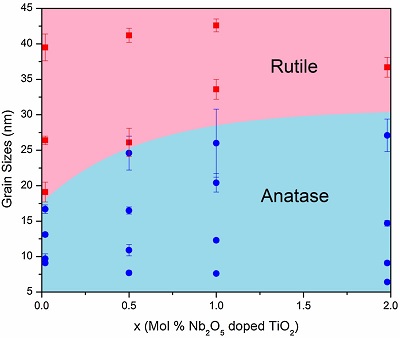
André da Silva: In my opinion, there were two very relevant contributions of the thesis.
The first concerns the scientific underpinnings of the anatase-rutile phase transformation of titanium dioxide (TiO2). It was proposed to chemically modify titanium dioxide by doping with niobium pentoxide (Nb2O5) and also understand the thermodynamic stability of the anatase-rutile phases. By means of the surface energy measurements and the enthalpy dissolution measurements, in which a non-existent laboratory structure was used in Brazil, a nanoscale phase diagram was created for TiO2 doped with Nb2O5, which predicts phase transformation through the crystallite size as a function of the chemical composition. It was observed that the doping of TiO2 with Nb2O5 thermodynamically stabilizes the anatase phase, delaying the phase transition temperature for rutile. Through the diagram it can be observed that niobium allows a larger growth of the TiO2 nanoparticles before the phase transformation occurs. This thermodynamic stability occurs through the segregation of Nb2O5 on the surface of the TiO2 nanoparticles, resulting in a decrease in the surface energy of the material.
The second contribution of the thesis is from the point of view of industrial application. The TiO2 doped with Nb2O5 in an optimized percentage was applied to the surface of ceramic coatings, which allowed the production of photocatalytic / self-cleaning ceramics with a higher performance than the current market. In addition, the proposed formulation allowed the sintering of the ceramic coatings at temperatures applicable to the industry, which was one of the major difficulties the companies faced in the manufacture of these coatings.
B-MRS Newsletter: Cite the main results generated from the award-winning thesis (papers, patents, products, startups, other awards, etc.).
André da Silva: During the time of the thesis, 9 international papers were produced, related directly or indirectly to the research theme, corresponding to high-impact indexed journals in areas related to Materials. Of these papers, I consider the first four (all in QUALIS A1 periodicals in the materials area) as the main ones related to the thesis.
- DA SILVA, A. L.; HOTZA, D.; CASTRO, R.H.R. Surface energy effects on the stability of anatase and rutile nanocrystals: A predictive diagram for Nb2O5-doped-TiO2. Applied Surface Science, v. 393, p. 103-109, 2017. https://doi.org/10.1016/j.apsusc.2016.09.126
- DA SILVA, A. L.; MUCHE, D.N.F. ; DEY, S.; HOTZA, D. ; CASTRO, R.H.R. . Photocatalytic Nb2O5-doped TiO2 nanoparticles for glazed ceramic tiles. Ceramics International, v. 42, p. 5113-5122, 2016. https://doi.org/10.1016/j.ceramint.2015.12.029
- DA SILVA, A. L.; DONDI, M.; HOTZA, D. Self-cleaning ceramic tiles coated with Nb2O5-doped-TiO2 nanoparticles. Ceramics International, v. 43, p. 11986-11991, 2017. https://doi.org/10.1016/j.ceramint.2017.06.049
- DA SILVA, A. L.; DONDI, M.; RAIMONDO, M.; HOTZA, D. Photocatalytic Ceramic Tiles: Challenges and Technological Solutions. Journal of the European Ceramic Society. https://doi.org/10.1016/j.jeurceramsoc.2017.11.039
- GOMEZ, S. Y.; DA SILVA, A.L.; GOUVEIA, D.; CASTRO, R. H. R.; HOTZA, D. Nanocrystalline yttria-doped zirconia sintered by fast firing. Materials Letters (General ed.), v. 166, p. 196-200, 2016. https://doi.org/10.1016/j.matlet.2015.12.042
- MIAGAVA, J.; DA SILVA, A.L.; NAVROTSKY, A.; CASTRO, R.H.R.; GOUVÊA, D. The Nanocrystalline SnO 2 -TiO 2 System-Part II: Surface Energies and Thermodynamic Stability. Journal of the American Ceramic Society, v. 99, p. 638–644, 2016. doi:10.1111/jace.13954
- DA SILVA, A.L.; FELTRIN, J.; DAL BÓ, M.; BERNARDIN, A.M. ; HOTZA, D. Effect of reduction of thickness on microstructure and properties of porcelain stoneware tiles. Ceramics International, v. 40, p. 14693-14699, 2014.
- DA SILVA, A. L.; FELTRIN, J.; BERNARDIN, A.M. Morphology and Fluidity of Spray-Dried Powder Transported by Compressed Air. Materials Science Forum (Online), v. 798-799, p. 334-339, 2014.
- DA SILVA, A. L.; BERNARDIN, A.M.; HOTZA, D. Forming of thin porcelain tiles: a comparison between tape casting and dry pressing. Ceramics International, v. 40, p. 3761-3767, 2013.
B-MRS Newsletter: In your opinion, what are the main factors that led to the outstanding research at the national level (your thesis)?
André da Silva: There are several factors that allowed the realization/award of the work conducted. I will highlight some factors:
Planning activities in a concise but detailed and organized manner.
The support, help and teachings from the advisors, who were always present, Prof. Dr. Dachamir Hotza (UFSC), Dr. Ricardo Castro (University of California, Davis, USA) and Michele Dondi (ISTEC, Faenza, Italy), as well as the support of the Graduate Program in Materials Engineering at the Federal University of Santa Catarina (PGMAT).
My ability to accept new challenges, in search of the knowledge necessary to carry out the work and the awareness that learning must be a constant habit, certainly were fundamental for the favorable development of the thesis. In addition to technical knowledge, I also emphasize the importance of mastering a new language, especially English, which opened the door to international collaborations, conferences and writing papers.
My family’s support, especially from my wife Caroline, always by my side, providing strength and encouragement.
I also highlight the International collaborations with the University of California, Davis, USA, Dr. Ricardo Castro and the Institute of Science and Technology of Ceramic Materials, Faenza, Italy, through Dr. Michele Dondi. These collaborations were also possible thanks to the CAPES and CNPq internship programs abroad.
B-MRS Newsletter: Leave a message to our readers who are undergraduate or graduate students.
André da Silva: A graduate or postgraduate degree, especially when working with research, is done like the construction of a wall. You should lay a brick a day, that is, do a little every day, but constantly focused and dedicated. Often, because we do not see immediate results, students end up steering away and the results are not as good as expected. Focus your efforts on what will generate the most of your results, take time to study and update yourself in your area and have a well-defined end goal. Do not forget to take care of your health, have friends and family nearby. Believe in yourself and in your potential, your work is very important for our country.
Interview with Juliano Avelar Araujo, winner of the award for the best thesis in the area of Engineering II
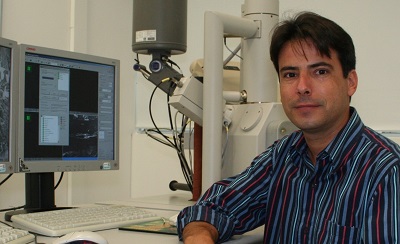
Thesis: Obtaining and microstructural and chemical characterization of multilayer NBN / CRN coatings for tribological applications by the physical vapor deposition process.
PhD Course in Metallurgical Engineering from the Polytechnic School of the University of São Paulo (Poli-USP).
Author: Juliano Avelar Araujo.
Advisor: Andre Paulo Tschiptschin (Poli-USP).
When Juliano Avelar Araujo, a metallurgical engineer, decided to do his doctorate nine years after completing his master’s degree in Surface Engineering, he was already working as a researcher in the Mahle group, a supplier and development partner of the global automotive industry. The company supported this initiative, and Araujo was able to study in detail a multilayer coating that, when applied to components of internal combustion engines, saves fuel and consequently reduces traffic-related pollution. In the thesis, he also presented a model that allows developing other nanostructured coatings for automotive applications. Currently working on research and development projects at the Mahle Technology Center, he is taking advantage of the knowledge gained through his PhD to develop products that are likely to be marketed in 2019.
B-MRS Newsletter: In your opinion, what is the most relevant contribution of the awarded thesis?
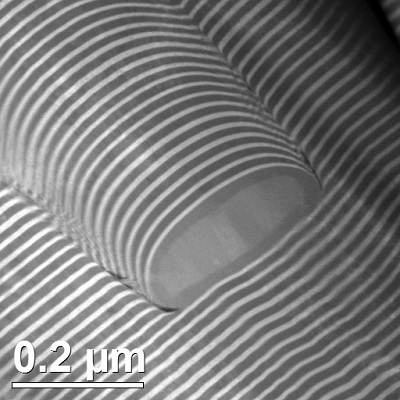
Juliano Araujo: The regulations of the automobile industry are increasingly oriented towards reducing the emission of polluting gases. Thus, components of the internal combustion engine must innovate characteristics such as mechanical losses by friction and wear reductions to obtain lower fuel consumption and consequently reduced emissions. In this line, the doctoral work explored and developed a coating that meets these characteristics, while also formulating a model that can be employed to accelerate the development of coatings to meet the functionality of the part throughout the engine’s lifespan.
B-MRS Newsletter: Cite the main results generated from the award-winning thesis (papers, patents, products, startups, other awards, etc.).
Juliano Araujo:: There were 3 articles in international publications: 2 journals (WEAR and Surface & Coatings Technology) and 1 journal (SVC), 1 paper published in annals of international conferences, 3 patent applications and the 2016 Environment AEA Award (Automotive Engineering Association ) – Honorable Mention – Academic Category, with the work “Morphology of nanostructured CrN/NbN coatings deposited by PVD,” of the authors Juliano Avelar Araujo, André Paulo Tschiptschin, Nelson Batista de Lima and Roberto Martins de Souza.
Papers:
- ARAUJO, JULIANO AVELAR; ARAUJO, GISELA MARQUES; SOUZA, ROBERTO MARTINS; TSCHIPTSCHIN, ANDRÉ PAULO. Effect of periodicity on hardness and scratch resistance of CrN/NbN nanoscale multilayer coating deposited by cathodic arc technique. WEAR. , v.330-331, p.469 – 477, 2015.
- ARAUJO, JULIANO AVELAR; SOUZA, ROBERTO MARTINS; LIMA, NELSON BATISTA DE; TSCHIPTSCHIN, ANDRÉ PAULO. Thick CrN/NbN Multilayer Coating Deposited by Cathodic Arc Technique. Materials Research-Ibero-american Journal of Materials. , v.20, p.200 – 209, 2017.
- ARAUJO, JULIANO AVELAR; GIORJÃO, RAFAEL ARTHUR REGHINE; BETTINI, JEFFERSON; SOUZA, ROBERTO MARTINS; TSCHIPTSCHIN, ANDRÉ PAULO. Modeling intrinsic residual stresses built-up during growth of nanostructured multilayer NbN/CrN coatings. SURFACE & COATINGS TECHNOLOGY. , v.308, p.264 – 272, 2016.
- ARAUJO, JULIANO AVELAR; MARQUES, G. A. Engineered PVD Coatings for Piston Rings application: Society of Vacuum Coaters. Spring Buletim, p. 46-52, 2012.
Patents:
- ARAUJO, J.A.; Piston ring for internal combustion engine with a multilayer coating applied by PVD_Niobium nitride WO2009155677-A1 – PCT/BR2009/000184 (PI0901939-1) US20110148047-A1 26/06/2009. ANEL DE PISTÃO PARA MOTOR DE COMBUSTÃO INTERNA, 2009. Categoria: Produto. Instituição onde foi depositada: INPI – Instituto Nacional da Propriedade Industrial. País: Brasil. Natureza: Patente de Invenção. Número do registro: PI0901939. Data de depósito: 23/06/2009. Data da concessão: 26/09/2017. Depositante/Titular: Juliano Avelar Araujo.
- ARAUJO, J. A. Multilayer CrN/Cr2N PVD, 2010. Categoria: Produto. Instituição onde foi depositada: INPI – Instituto Nacional da Propriedade Industrial. País: Brasil. Natureza: Patente de Invenção. Número do registro: PI09023399. Número do depósito PCT: 9023399. Data de depósito: 29/06/2010. Depositante/Titular: Juliano Avelar Araujo. Depositante/Titular: Mahle Metal Leve.
- ARAUJO, JULIANO AVELAR; MORDENTE, P. J. R. ELEMENTO DESLIZANTE PARA MOTORES DE COMBUSTÃO INTERNA, 2016. Categoria: Produto. Instituição onde foi depositada: INPI – Instituto Nacional da Propriedade Industrial. País: Brasil. Natureza: Patente de Invenção. Número do registro: BR1020160153921. Data de depósito: 30/06/2016. Depositante/Titular: Juliano Avelar Araujo.
B-MRS Newsletter: In your opinion, what are the main factors that led to the outstanding research at the national level (your thesis)?
Juliano Araujo: I start with the teaching institution (University of São Paulo – USP/POLI) where I developed the doctoral work based on its tradition and recognized projection in the academic world, also the experienced guidance of Professors Dr. Andre Tschiptschin and Roberto Martins. Allied to this, the most modern techniques and equipment in the world were used, the exchange of experience with the most important laboratories and researchers in the area of coatings deposited by PVD, and the support and backing from MAHLE Metal Leve where I am a Research Engineer at the Technological Center. And finally, much discipline.
B-MRS Newsletter: Leave a message to our readers who are undergraduate or graduate students.
Juliano Araujo: Once or twice I thought about giving up on my doctorate because I believed I could not finish the thesis, I also thought about not enrolling in the Capes de Thesis Prize, because I felt I would not be competitive enough. We often underestimate ourselves… and sometimes it’s really good to be wrong! Do not give up!
Interview with Robson Rosa da Silva, winner of the honorable mention in the Chemistry area
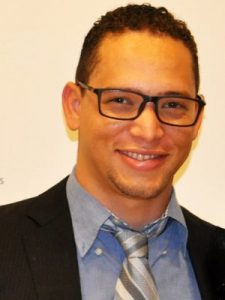
Thesis: New photonic structures: I – Self assembly of 1D Te structures; II – Multifunctional biopolymers and reused plastics.
PhD Course in Chemistry from the Araraquara Institute of Chemistry of the São Paulo State University Júlio de Mesquita Filho (UNESP).
Author: Robson Rosa da Silva.
Advisors: Sidney Jose Lima Ribeiro (UNESP) and Pedro H. C. Camargo (USP)
During Robson da Silva’s doctorate there was no lack of collaborations or scientific discussions, both with Brazilian laboratories and with international groups (the latter, from the internships at the NIMS, Japan, and Georgia Institute of Technology, USA). Robson da Silva’s thesis presents a collection of nanostructures, including one-dimensional structures, produced in order to control the shape (helices, wires and tubes) from tellurium, silver and copper. The work also reports the manufacture of films based on natural and synthetic polymers. All these materials have in common their applications in the Photonics area. Robson da Silva holds a Bachelor’s degree, a Master’s and a PhD in Chemistry. He is currently a postdoctoral fellow at the São Carlos Institute of Physics at the University of São Paulo (IFSC-USP).
B-MRS Newsletter: In your opinion, what is the most relevant contribution of the awarded thesis?
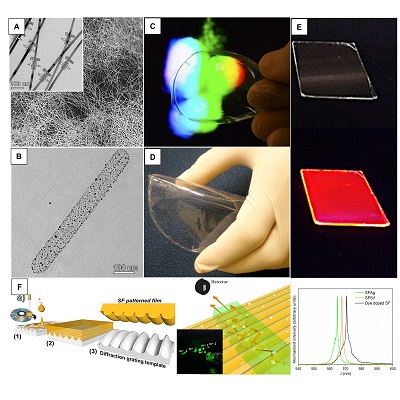
phenolic resin modified with nanoparticles of
gold. 1D tellurium nanostructures were used as
mold of sacrifice. C) and D) Hybrid Film Photographs
of fibroin and cellulose acetate, respectively, modified with
fibroin epoxysilane; E) Thin films of
recycled expanded polystyrene containing
europium under white light illumination (upper part) and black light
(lower part); F) Bragg gratings of silk doped fibroin with
rhodamine obtained by the replica of the
diffraction of a DVD. The introduction of light scattering nanoparticles
(such as silver and silica nanoparticles) in the Bragg grids of
fibroin has been shown to be efficient for laser
distributed feedback.
Robson Rosa da Silva: I believe that the best description of the thesis is that it is the result of multifaceted and interdisciplinary works in the field of photonics and nanomaterials. Due to its anisotropic structure, tellurium (Te) is one of the simplest materials to produce one-dimensional structures on a nanoscale, assuming different forms such as wires and tubes. From the work developed in the master’s, we discovered a scalable synthesis route to produce nanohelices, until then not found in the literature. We used Te nanohelices and functionalized their surface with phenolic resin for developing multifunctional 1D hybrids. Regarding the preparation of optically active materials, we have demonstrated that Te nanohelices are excellent sacrificial molds for the preparation of one-dimensional hybrid structures containing metallic nanoparticles (Ag and Au) and luminescent ones based on lanthanide ions. This work includes the collaboration of Professor Katsuhiko Ariga and Dr. Lok Shrestha who supervised me during the two-month internship period at the National Institute for Materials Science (NIMS), Japan.
I worked under Prof. Younan Xia of the Georgia Institute of Technology, USA, for one year, and continued working with one-dimensional nanostructures, however, obtained through metals such as silver and copper. During this period, I adapted the polyol synthesis to obtain ultrafine silver nanowires and collaborated with two other works related to the synthesis of ultrafine copper nanowires and silver nanorods. I also investigated the preparation of photonic crystals and magnetic nanocomposites encapsulated in metallic particles.
The thesis presents a series of studies that evaluate the potential of biopolymers (natural polymers and their derivatives) as host matrix for the incorporation of optically active species. In this case we evaluated luminophores (nanoparticles and complexes) derived from lanthanide ions. Some of the matrices investigated are soluble derivatives of cellulose, fibroin extracted from the cocoon of silkworms and cellulose biosynthesized by bacteria. These matrices can be processed in the form of transparent films, micrometric waits, sponges, etc., and also modified with dielectric, magnetic and metallic nanoparticles to produce functional materials.
Although biodegradable and transparent in the visible region, films derived from these biopolymers have few functional groups and are fragile. One of the contributions of this thesis is the successful modification of these matrices with organic-inorganic hybrids based on epoxysilanes by the sol-gel process and the simultaneous incorporation of lanthanide ion-based luminophores. This allowed producing films with excellent optical quality, rich in functional and non-cytotoxic groups and with superior mechanical properties compared to the pure biopolymer matrix with potential application in biophotonics.
In particular, we have demonstrated that silk fibroin is an extremely interesting matrix for replicating diffraction gratings and for harboring light scattering nanoparticles. Together with physicists from the Federal University of Pernambuco, we combined these materials to evaluate the synergism of a hybrid laser system formed by a distributed feedback laser and a random laser.
Finally, we investigate the recovery of plastics, whose recycling by traditional routes is not attractive, for the manufacture of high-optical quality thin films and with the potential to be used as wave guides. Some of the plastics studied include expanded polystyrene (Isopor®) and polycarbonate. The most important contribution is the fact that we used a dissolution route based on green solvent derived from plants, which allow incorporating emitting luminophores in the visible region.
B-MRS Newsletter: Cite the main results generated from the award-winning thesis (papers, patents, products, startups, other awards, etc.).
Robson Rosa da Silva: The results of the studies investigated during the doctoral period were published in scientific journals, book chapters and patents, besides national and international conferences.
From these publications, I would highlight the following works:
- ACS Applied Materials and Interface: Fabrication of Biocompatible, Functional, and Transparent Hybrid Films Based on Silk Fibroin and Epoxy Silane for Biophotonics. v.9 (33), 27905-27917.
- ACS Nano: Facile Synthesis of Sub-20 nm Silver Nanowires Through a Bromide-Mediated Polyol Method. v. 10 (8), 7892-7900, 2016.
- Journal of Materials Chemistry C: Silk fibroin biopolymer films as efficient hosts for DFB laser operation. v.1 (43), 7181-7190, 2013
- Journal of Sol-Gel Science and Technology: Multifunctional organic–inorganic hybrids based on cellulose acetate and 3-glycidoxypropyltrimethoxysilane. v.81(1), 114–126, 2017.
- ACS Nano: Facile synthesis of Ag nanorods with no plasmon resonance peak in the visible region by using Pd decahedra of 16 nm in size as seeds. v.9 (10), 10523-10532, 2015.
B-MRS Newsletter: From your point of view, what are the main factors that led to the outstanding research at the national level (your thesis)?
Robson Rosa da Silva: I believe that the factors that allowed conceiving the works that comprise the thesis arise from when we identified the balance between opportunity, confidence and pleasure in what is being done.
The main factor I emphasized here was the support, guidence, credibility and friendship of Professor Sidney J. L. Ribeiro. The dynamic mentoring I received has certainly helped to spark a definite variety in the research, sowing opportunities to interact with high-level researchers and research centers of excellence. The Laboratory of Photonic Materials in Araraquara has always advanced an environment of rich scientific discussions and collaborations, as well as provide an excellent infrastructure for the characterization of the materials in this thesis.
I attribute the research success to the co-orientation of Prof. Pedro Camargo from USP in São Paulo, who undoubtedly helped perfect the thesis with very productive and challenging discussions.
The internships abroad were in fact one of the factors that positively allowed to accomplish high quality work. Posture, professionalism, administration and discipline in research are values that have contributed greatly to my evolution as a researcher.
I also think it is very important to supervise and coordinate scientific activities in the post graduate program. The assistance of these researchers was indispensable to carry out the projects. Moreover, assemble an efficient and solid network of collaborators during my post-graduate studies has been an essential point to develop the research carried out. y of Microscopy of the National Laboratory of Nanotechnology and the institutional infrastructure of the National Institute of Photonics (INFO) was fundamental, in addition to the financial support of CAPES and FAPESP (13/12367-6) during the doctorate.
Above all, family support was crucial.
B-MRS Newsletter: Leave a message to our readers who are undergraduate or graduate students.
Robson Rosa da Silva: The message I would like to leave is inspired by a phrase I saw during the internship at NIMS, of unknown authorship: “The fruits of your research are proportional to the number of conversations with others.” So talk, question, but also listen, interpret the criticisms and do not stop trying to seriously solve the daily demands that surround us… and there are many. In research, feel uncomfortable because everything that is very comfortable creates inertia.
